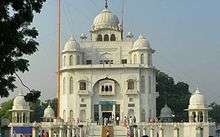Gurdwara Rakab Ganj Sahib
The Gurdwara Rakab Ganj Sahib is a historic gurdwara near Parliament House in New Delhi. It was built in 1783, after Sikh military leader Baghel Singh Dhaliwal (1730–1802) captured Delhi, on 11 March 1783, and his brief stay in Delhi, led to the construction of several Sikh religious shrines within the city. This one marks the site of cremation of the ninth Sikh Guru, Guru Tegh Bahadur, after his martyrdom in November 1675 for saving Hindu Kashmiri Pandits, under orders of Aurangzeb. The Gurudwara Sahib is built near old Raisina village near Raisina Hill, at present Pandit Pant Marg, took 12 years to build. Prior to that, a mosque had been built near the spot; eventually later Mughal emperor Shah Alam II gave the permission to build a Gurdwara sahib there.[1]
| Gurudwara Rakab Ganj Sahib | |
|---|---|
 Gurdwara Rakab Ganj Sahib Delhi 
| |
| Religion | |
| Affiliation | Sikhism |
| Location | |
| Location | Pandit Pant Marg,Gurdwara Rakab Ganj Road, New Delhi, India. |
| State | Delhi |
| Geographic coordinates | 28°37′5.473″N 77°12′17.327″E |
| Architecture | |
| Style | Sikh architecture |
| Completed | again rebuilt in 1783, current structure mostly built post 1947 |
The Gurdwara Rakabganj sahib is also home to the Delhi Sikh Gurdwara Management Committee.
History
The Gurdwara marks the site, where Lakhi Shah Banjara and his son Bhai Naghaiya burnt their own house to cremate the headless body of the Sikh Guru Guru Tegh Bahadur sahib who, on 11 November 1675, was martyred by beheading at Chandni Chowk on the orders of the Mughal emperor Aurangzeb for refusing to convert to Islam and buried the ashes in the house itself. In 1707 when Guru Gobind Singh tenth Sikh guru come to Delhi to meet prince Muzaum later Mughal king Bahadur Shah I , he located the place of cremation with help of local Sikhs and built a simple Memorial there. Later a mosque came to be built at site which s. Baghel Singh had to demolish in 1783 to raise gurdwara at the place. Muslims again built a mosque at site during mutiny of 1857. Sikhs took the matter to court which decided in favour of Sikhs and they quickly rebuilt the Gurdwara.Another dispute arose when during 1914 a portion of boundary wall was demolished by British Goveronment to straighten a passage to viceregal building.On a protest and agitation raised by Sikhs Goveronment yielded as soon as World War I came to end in 1918, and boundary wall was rebuilt at public expense. Construction of present building was started in 1960 and was completed in 1967–68.[2]
The spot where the Guru sahib were beheaded is marked by Gurdwara Sis Ganj Sahib. The Guru sahib's severed head was brought from Delhi to Anandpur Sahib in Punjab by Bhai Jaita ji (later Bhai Jiwan Singh) and was cremated by his son, Guru Gobind Rai, who later became Guru Gobind Singh, the tenth Guru of the Sikhs.[1][3][4]
The Delhi Sikh Gurdwara Management Committee has made a 1984 Sikh Genocide Memorial there in Gurdwara complex to memorise large scale violence that existed against Sikhs during 1984. In this names of those killed are transcribed on a wall.[5][6][7]
References
- H. S Singha (2000). The encyclopedia of Sikhism. Hemkunt Press. p. 187. ISBN 81-7010-301-0.
- "DELHI". eos.learnpunjabi.org. Retrieved 28 July 2019.
- H.S. Singha (2005). Sikh Studies, Book 7. Hemkunt Press. p. 43. ISBN 81-7010-245-6.
- Mohindar Pal Kohli (1992). Guru Tegh Bahadur: testimony of conscience. Sahitya Akademi. p. 36. ISBN 81-7201-234-9.
- Jan 16, TNN | Updated; 2017; Ist, 0:17. "1984 memorial opens amid tears, hint of politics | Delhi News - Times of India". The Times of India. Retrieved 28 July 2019.CS1 maint: numeric names: authors list (link)
- "In pictures: The Wall of Truth, a memorial for victims of 1984 anti-Sikh riots". CatchNews.com. Retrieved 28 July 2019.
- Nibber, Gurpreet Singh (12 June 2013). "Foundation stone of 1984 Sikh genocide memorial laid". Hindustan Times.